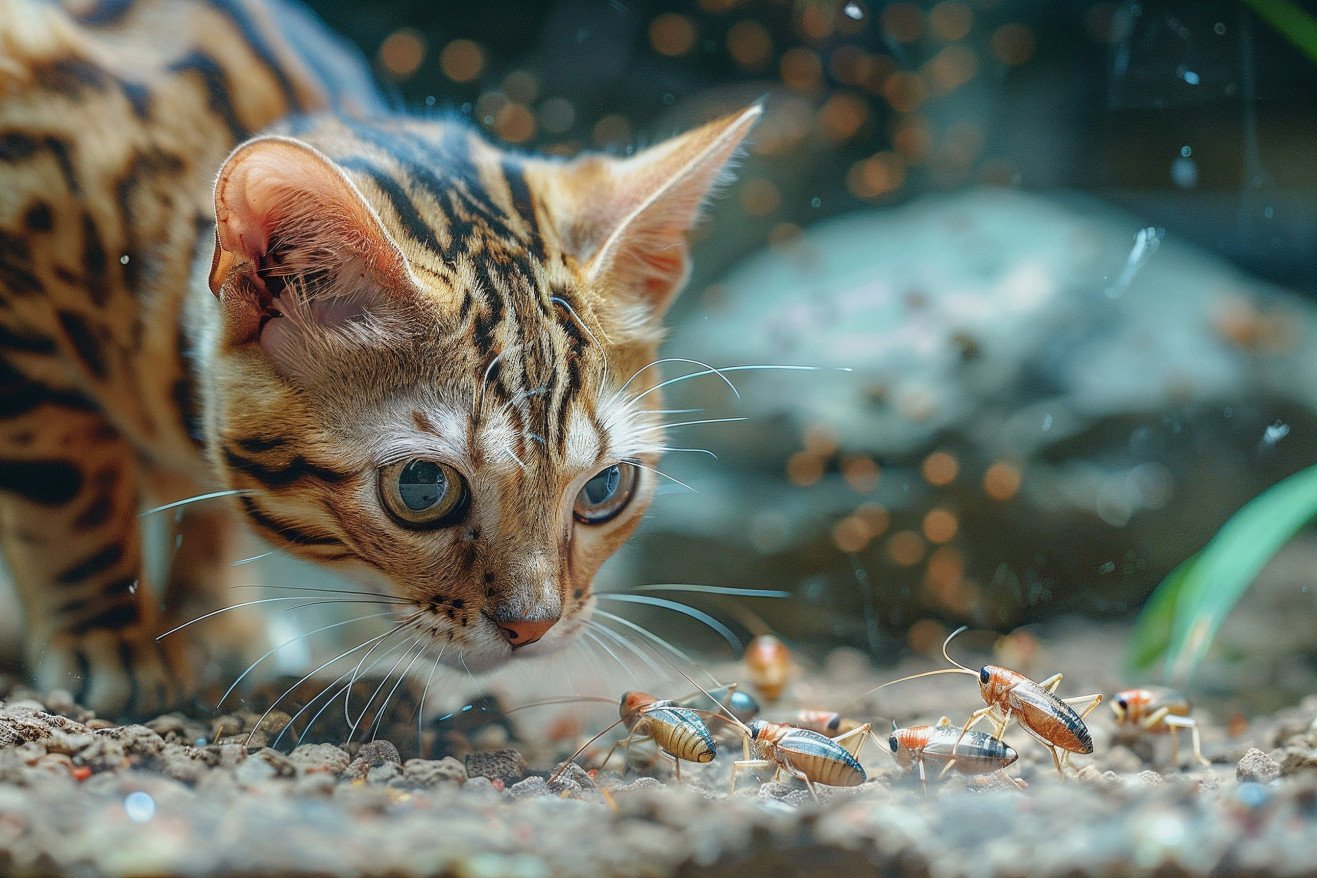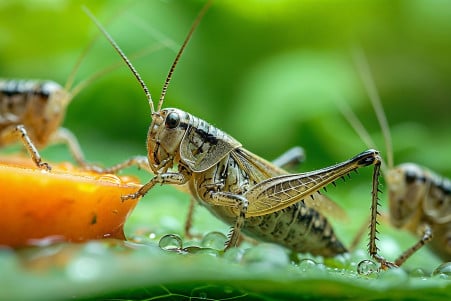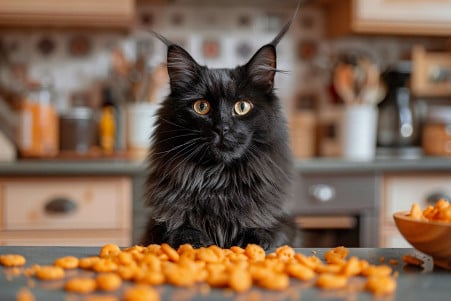Can Cats Eat Crickets? A Look at Insect Nutrition for Felines
14 May 2024 • Updated 14 May 2024

If you've ever seen your cat eyeing a cricket, you may have wondered if it's OK to let them eat it. While cats are obligate carnivores and can technically eat crickets as a treat in moderation, they should not be a regular part of their diet since crickets are not nutritionally complete for cats.
So, while the occasional cricket is fine, we'll take a look at veterinary research on feline nutrition and talk to experts to find out if crickets are a good choice for a cat's snack. This information will help you understand the potential benefits and drawbacks so you can decide if you want to try this novel protein source with your cat. We'll also discuss other options that offer more complete nutrition that's better suited to your cat's dietary requirements.
Can cats eat crickets?
Nutritional Value: What Are the Benefits of Crickets for Cats?
Crickets are a great source of protein, essential amino acids, and a variety of vitamins and minerals that can be beneficial to cats. As a study from the National Center for Biotechnology Information explains, the protein content of insects, including crickets, is high and similar to soybean meal (40-45%) and meat meal (40-50%), and the amino acids in insects have high digestibility (76-98%), which is similar to animal proteins. Crickets are especially high in glutamic acid, which is associated with the "umami" taste that cats love, according to CatCentric.
In addition to being a concentrated protein source, crickets are also a good source of important nutrients, including iron, calcium, and omega-3 fatty acids. The same NCBI study explains that insects are high in minerals, including copper, iron, magnesium, manganese, phosphorus, selenium, and zinc, and are also rich in vitamins, including riboflavin, pantothenic acid, biotin, and, in some cases, folic acid. The fats and minerals in crickets can help cats in a variety of ways, including supporting muscle growth, maintaining healthy skin and fur, and helping with other bodily processes.
While they shouldn't be the sole source of nutrition, the nutritional content of crickets is similar to that of traditional protein sources, which means they could be a good option as a supplement for cats. In fact, because of their high nutrient content, a smaller amount of cricket meal is needed to meet a cat's protein and lipid requirements compared to chicken, as the NCBI study explains. However, as we'll discuss in the next section, there are also some potential downsides and risks to keep in mind when it comes to feeding your cat crickets.
Potential Risks and Concerns: What Cat Owners Should Know
Despite the potential nutritional value of crickets, there are some risks associated with feeding them to cats. As Hepper explains, crickets could contain parasites, bacteria, or other pathogens that could pose a risk to cats if they are not handled or sourced correctly. Cats could also experience gastrointestinal upset, allergies, or choking hazards if they are not fed crickets properly.
Catster stresses the importance of using commercially raised crickets that are specifically bred for pet use to minimize the risks. They explain that wild-caught or improperly sourced crickets could contain parasites that could be transmitted to cats. Meanwhile, Animal Gator warns that cat owners should be aware of any pesticide or chemical residues on the crickets, as these could have an impact on a cat's health.
In the end, while the occasional cricket may not pose a risk to a cat, pet owners should be aware of the potential dangers and ensure that they are sourcing crickets from reputable suppliers. It's also important to make sure that the crickets are handled and prepared properly to ensure that both the cat and the owner have a safe and positive experience.
Safe Feeding: How to Feed Crickets to Your Cat
If you choose to feed crickets to your cat, it's important to do so in a way that prioritizes their health and safety. According to WebMD, crickets should be fed in small amounts and introduced slowly because a sudden change in diet can cause digestive upset. You should also watch your cat's response to crickets and adjust portion sizes based on how they react.
When it comes to preparing crickets for your cat, WebMD says that you should remove legs or wings to prevent choking. Meanwhile, Truth about Pet Food explains that crickets are not an AAFCO approved pet food ingredient, so cat parents should talk to their vet before feeding them to their cats, especially if they have kittens, senior cats, or cats with health issues. They should also ask about potential drug interactions.
Feeding crickets to cats should be done responsibly and in moderation. Make sure to watch your cat's response to crickets and adjust portion sizes as needed to make sure that they are safe and healthy.
Regulatory Landscape: What Are the Legal and Safety Implications?
The use of crickets and other insects as pet food ingredients is still a relatively new and emerging field. While the FDA considers insects to be food if that is the intended use, the regulatory landscape in the United States is still developing, as noted by The Future Of Edible Insects.
According to the Petfood Industry, the Association of American Feed Control Officials (AAFCO) has only approved dried black soldier fly larvae as an ingredient in adult dog food. Currently, AAFCO is not considering any insect-based ingredients for cat food.
The Burdock Group explains that the FDA has taken a relatively hands-off approach to regulating insects as food. While the FDA requires that insects be clean, wholesome, and produced under sanitary conditions, the agency has not provided much additional guidance. In addition, there are concerns about contaminants, allergens, and the need to prove the safety and nutritional value of insect-based pet food ingredients.
As the pet food industry's use of alternative protein sources grows, LANI suggests that the regulatory landscape may change. However, for now, cat parents should be wary and talk to veterinary professionals before adding crickets or other insects to their cat's diet.
Other Alternative Protein Options for Cats
While crickets have some nutritional advantages, they may not be the best protein source for every cat or cat owner. Luckily, there are several other alternative protein options that are becoming more popular in the pet food industry that you may want to consider.
As reported by Pet Food Processing, duck is a nutritious and flavorful lean meat that is similar in fat and calories to skinless chicken or turkey. It is a great source of selenium and zinc, and because it is a red meat, it contains more iron than other poultry. The PetMD article also explains that fish are a natural source of omega-3 fatty acids, which can promote healthy skin and coats and have anti-inflammatory properties.
In addition to animal-based proteins, FutureBridge reports that plant-based protein sources like soybeans, peas, lentils, and algae are becoming increasingly popular in the pet food industry. These options may be more sustainable and less allergenic for cats. The Feline Wellness Online article explains that it's important to feed cats a variety of protein sources to help prevent allergies.
In the end, if you're considering other alternative protein sources for your cat, make sure to pick options that are high-quality, well-balanced, and meet your cat's specific nutritional requirements. Your vet can help you make sure you're feeding your feline friend the best diet possible.
How to Introduce Crickets to Your Cat
As with any new protein source, it’s important to introduce crickets to your cat’s diet slowly to avoid gastrointestinal upset. According to Hill's Pet, cats need to be transitioned to new cat food slowly to avoid stomach upset. Since cats can be suspicious of change, especially when it comes to new foods, a little canned food can be a big help in getting them to accept a new food.
Purina recommends a 10-day transition that starts with 75% old food and 25% new food, then gradually increases the amount of new food over the course of the next several days. It’s important to watch your cat’s response and adjust the transition schedule as needed. Mud Bay also notes that some cats may benefit from the addition of digestive supplements like prebiotics and enzymes during the transition.
If your cat experiences ongoing digestive upset or refuses to eat during the transition, PetMD recommends contacting your vet, as a lack of protein in the diet can lead to serious health issues. No matter what protein source you’re introducing, patience and a slow transition are the best ways to help your cat adjust.
Conclusion: What's Best for Your Cat?
The decision to feed crickets or other alternative protein sources to your cat should be made with careful consideration of your cat's overall health and nutritional requirements. While crickets can offer some nutritional value, there are also potential downsides that need to be taken into account.
In the end, the occasional cricket is not likely to cause any harm, but they should not be a regular part of your cat's diet. Cats are obligate carnivores and need a well-balanced diet that includes high-quality animal proteins to stay healthy. Any new food should be introduced gradually and with close attention to your cat's reaction.
If you're thinking about adding crickets or another alternative protein source to your cat's diet, it's best to talk to your veterinarian first. They can offer personalized advice based on your cat's specific nutritional needs and help you make a decision that's in your cat's best interest.


